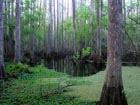
Cypress swamp in central Florida [©Vladimir Dinets 2006] More photos can be seen HERE (2006.03.22).
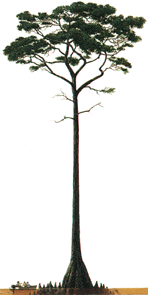
Representative painting of an old-growth tree on the floodplain at Congaree Swamp National Park, SC (National Park Service 1995).
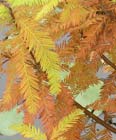
Foliage on a tree of var. distichum at the North Carolina Botanical Garden, Chapel Hill, NC [C.J. Earle, 2004.10].
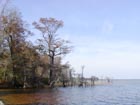
A shoreline stand at Lake Waccamaw State Park, North Carolina [C.J. Earle, 2003.11.26].
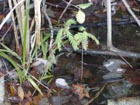
Seedlings at Lake Waccamaw State Park, North Carolina [C.J. Earle, 2003.11.26].
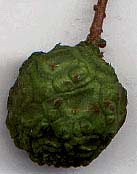
Immature female cone from a tree at the Sacramento Capitol Arboretum [C.J. Earle].
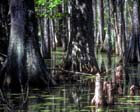
Trees and cypress 'knees' [Dr. Linda B. Brubaker].
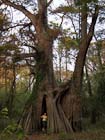
The "big tree" of var. distichum; at Cat Island, Louisiana [©Vladimir Dinets 2012].
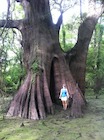
Another view of the Cat Island tree [Perry Bubby Booth 2019].

Conservation Status

Taxodium distichum
(Linnaeus) Richard 1810
Common names
Baldcypress, cypress, swamp cypress; ラクウショウ [Japanese].
Taxonomic notes
Synonymy: See the varieties. Two varieties, distichum and imbricarium (often spelled imbricatum, which has the advantage of being an actual word that refers to imbricate leaves, but "imbricaria" was used in Nuttall's original 1818 description and thus is correct). See Taxodium for a discussion of the generally very close relationships between taxa in this genus and thus the rationale for not segregating var. imbricarium as a species in its own right.
Description
Monoecious, deciduous or semi-deciduous trees to 40 m tall and 3 m dbh, usually with a single straight trunk, a broad base, and often with brown, woody “knees” projecting up to 1 m from the ground nearby; forming a pyramidal crown that flattens in old trees. Bark light brown, turning grey, exfoliating in long, thin strips. Shoots dimorphic, slender, green to light brown, each year’s growth consisting of a single indeterminate long shoot with multiple determinate lateral short shoots. Leaves variably deciduous (with the shoot, as is general in Cupressaceae) depending on location (short or long shoots) and climate; winter-deciduous in temperate areas, but lasting a year or more in subtropical areas. In swamp cypress (variety distichum) leaves are in 2 ranks, 10-17 mm long; in pond cypress (variety imbricarium) the leaves are tightly appressed to the branchlet and 3-10 mm long. Seed cones round, 1.5-4 cm diameter, green and fleshy when young, at maturity brown and woody with 5-10 seed scales (Watson 1993 and pers. obs.). See García Esteban et al. (2004) for a detailed characterization of the wood anatomy.
Distribution and Ecology
USA: Alabama, Arkansas, Delaware, Florida, Georgia, Illinois, Indiana, Louisiana, Mississippi, Missouri, Kentucky, Maryland, North Carolina, Oklahoma, South Carolina, Tennessee, Texas, and Virginia; Mexico (Watson 1993, Thompson et al. 1999), in riparian and wetland habitats. Also widely planted as an ornamental, for instance, in Oregon and Washington. Hardy to Zone 6 (cold hardiness limit between -23.2°C and -17.8°C) (Bannister and Neuner 2001).
Distribution data from USGS (1999). Points plotted as tree icons represent isolated or approximate locations.
Remarkable Specimens
Until January 15, 2012, the largest known specimen it was a noble tree of var. imbricarium, but now the largest survivor belongs to var. distichum.
The oldest tree, 2,624 years, grows along the Black River in North Carolina, as detailed in the discussion of var. distichum. Only four species of trees, all conifers, are known to attain greater ages (see How Old Is That Tree?).
Ethnobotany
This is a valuable timber tree. The knees are frequently used for curved members in the construction of wooden boats (Encarta 1997). This was also one of the first New World species brought home to England, introduced there by Tradescant in 1637 (Folsom 2003).
The species has proven valuable in dendrochronological research. The oldest tree was found in the course of a dendrochronological investigation of Black River Swamp baldcypress groves in North Carolina. A variety of other studies have also been performed, mostly addressing ecological questions, but also to reconstruct climatic variation. In 2016, the researchers responsible for this work initated The Ancient Bald Cypress Consortium, an organization whose stated mission is "the preservation of ancient bald cypress forest ecosystems... The oldest bald cypress trees have been found along the Black River, North Carolina, which is one of the most remarkable natural areas in the country. The Black River bald cypress preserve a major scientific record of climate variability and change in their annual growth rings... The Nature Conservancy has preserved nearly 9,000 acres of habitat on and adjacent to the floodplain of the Black River, including some 3,000 acres with millennium-old trees. However, recent research indicates that hundreds of additional acres of
ancient bald cypress forests are not protected along the Black River or on other streams in the vicinity. Unfortunately, continued logging, biomass harvesting, and land development threaten all old-growth stands on the Black River not specifically protected by The Nature Conservancy. This project seeks $1.3 million to preserve uncut and unprotected ancient bald cypress forest remnants along the Black River."
Observations
Have seen it at the Black River Swamp in southeast North Carolina (near Moores Creek National Battlefield), where some specimens are up to 130 cm in diameter above a butt swell that extends 3-4 m up the trunk. All the trees in the area have lost their tops in past hurricanes and are, like the neighboring hardwoods, only 20 to 30 m tall, but some specimens have yielded core samples containing over 1600 rings. Old-growth baldcypress forest can also be found in Congaree Swamp National Park, South Carolina; in the Okefenokee Swamp on the Georgia-Florida border; and in various other protected areas.
It forms a stately landscape tree, and is widely planted in parks and other ornamental settings.
Remarks
Of all trees, it has perhaps the greatest known tolerance for flooding; trees planted at Blue River reservoir in Oregon are submerged for several months each year, including about half of the growing season.
Baldcypress is the state tree of Louisiana (Watson 1993).
Citations
Folsom, J. (ed.). 2003. Plant Trivia TimeLine. PlantEd, Huntington Botanical Gardens, 1151 Oxford Road, San Marino, CA 91108-1299.
National Park Service. 1995. Congaree Swamp Official Map and Guide. Washington, DC: U.S. Government Printing Office [Paintings by John Dawson].
Richard, L. C. M. 1810. Note sur les plantes dites Conifères. Ann. Mus. Natl. Hist. Nat. (Paris) 16:296-299.
Van Pelt, Robert. 1998. Telephone communication 1998.11.14 from Robert Van Pelt, who measured these trees in November 1998.
See also
Elwes and Henry 1906-1913 at the Biodiversity Heritage Library (Photos). This series of volumes, privately printed, provides some of the most engaging descriptions of conifers ever published. Although they only treat species cultivated in the U.K. and Ireland, and the taxonomy is a bit dated, still these accounts are thorough, treating such topics as species description, range, varieties, exceptionally old or tall specimens, remarkable trees, and cultivation. Despite being over a century old, they are generally accurate, and are illustrated with some remarkable photographs and lithographs.
Farjon (2005).
Prasad and Iverson (1999).
The Ancient Bald Cypress Consortium.









